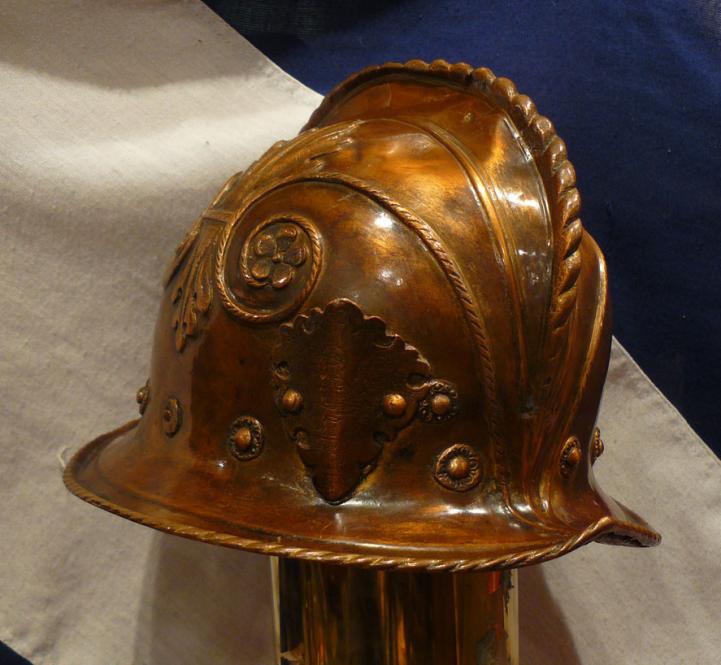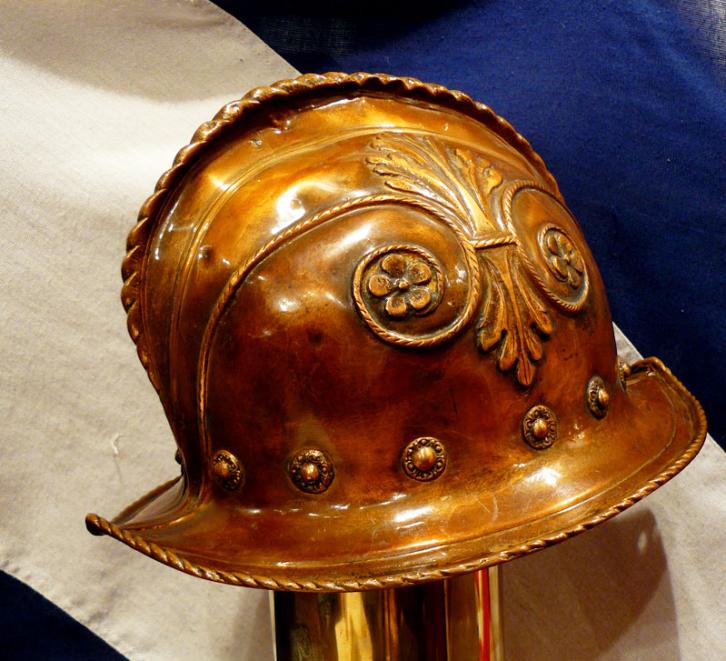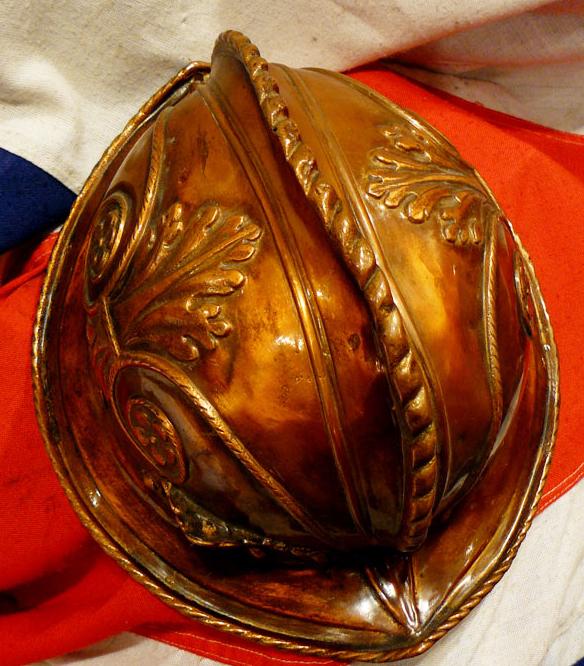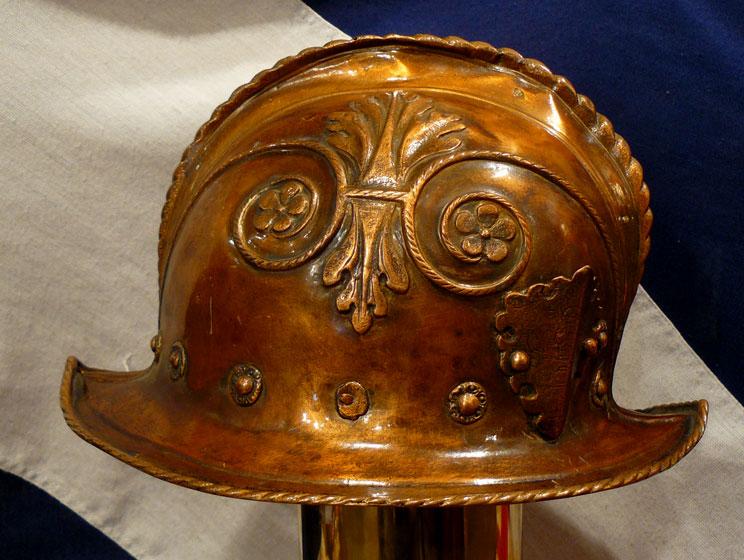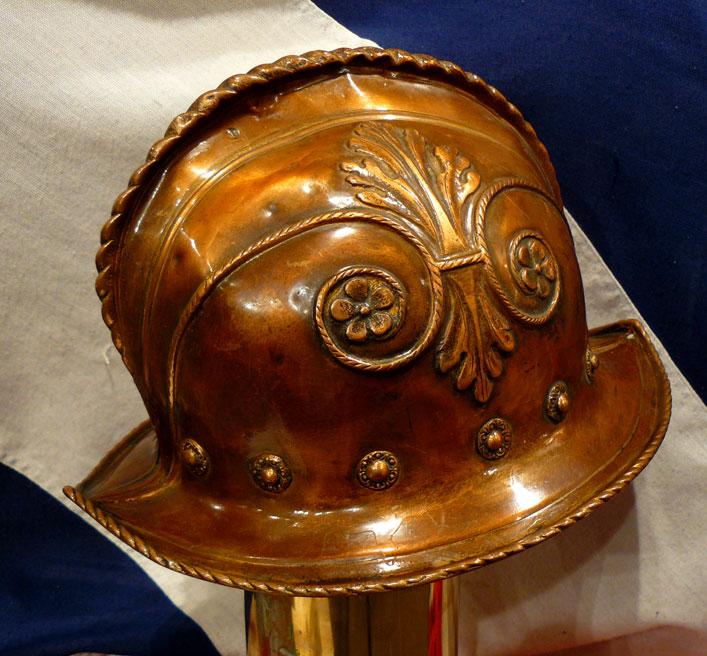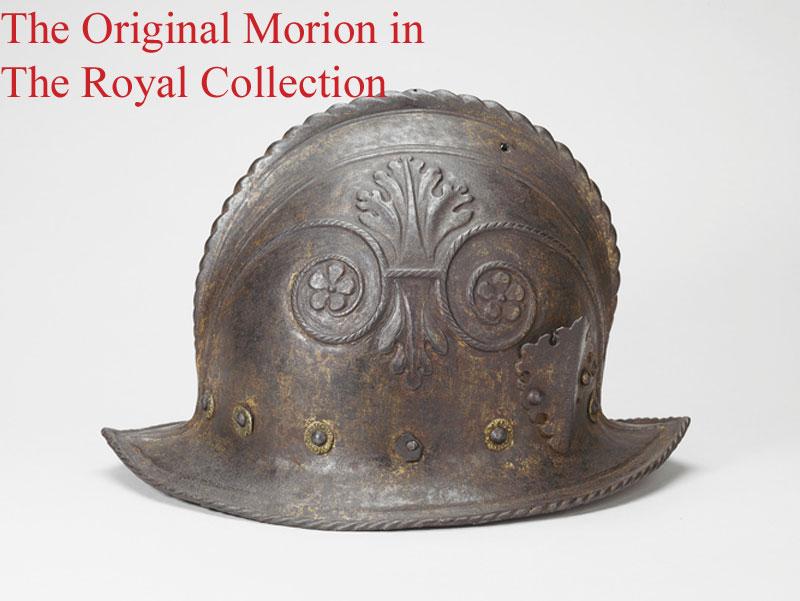A Former Helmet Created From a Helmet in the Royal Collection. A Victorian, Italian Morion Helmet, Probably From Milan, Circa 1544. Likely Created by Instruction From The Curators Of the Royal Collection In Around 1873
This is likely a unique copy made in the 19th century directly from a fabulous helmet in the Royal Collection, in the Round Tower at Windsor Castle, and believed to be from the personal collection of King George IIIrd. Naturally as the original would never become available this is a unique opportunity to own a simulacrum from Her Majesty’s armoury. This stunning helmet was made in the 19th century using the incredibly advanced copper electrotype system with fully faithful and exact detail from the royal helmet. A system so exact in its ability to recreate an identical version of the original, it was considered by some to be a magical marvel. It has a slightly misshapen damage at the comb. The plume holder etched with a religious scene (possibly the Trinity) and the inscription LAVDAMVS TE (We praise Thee) . In the Round Tower at Windsor Castle in 1904. The collection of George III included ‘A Helmet English, Very Ancient Made of Iron – Embossed with Scrolls – Stars and Leaves had formerly been Gilt’, which was sent to the armoury from Buckingham House on 20 September 1821.
Item no. 2048 in the North Corridor Inventory, which records the arrangement of the Collection at Windsor Castle. We believe it was most likely made by instruction from the curators of the Royal Collection, that commissioned a identical copy made, possibly for the national museum collection, such as the amazing plaster copies of unique worldwide masterpieces in the V&A. Opened in 1873, the Cast Courts display copies of some of the world's most significant works of art reproduced in plaster, electrotype, photography, and digital media. The cast collection is famous for including reproductions of Michelangelo's David, Trajan's Column, and Ghiberti's Gates of Paradise, amongst many others. Electrotyping was an incredible chemical method for forming metal parts that exactly reproduce a model. The method was invented by Moritz von Jacobi in Russia in 1838, and was immediately adopted for applications in printing and several other fields. As described in a treatise, electrotyping produces "an exact facsimile of any object having an irregular surface, whether it be an engraved steel- or copper-plate, a wood-cut, or a form of set-up type, to be used for printing; or a medal, medallion, statue, bust, or even a natural object, for art purposes." In art, several important "bronze" sculptures created in the 19th century are actually electrotyped copper, and not bronze at all One of the earliest documented large-scale (1.67 metres (5.5 ft)) electrotype sculptures was John Evan Thomas's Death of Tewdric Mawr, King of Gwent (1849). The electrotype was done by Elkington, Mason, & Co. for the Great Exhibition of 1851. Link to see the original example http://www.royalcollection.org.uk. The gallery shows a photo of the original Italian morion still in the Royal Collection, but made in iron, however, it was originally fully gilded, which this copy still appears to be, likely in order to show how it once looked when it was originally made in around 1544 in Italy. It is not often any collector has the opportunity to purchase an absolute identical version of a piece of armour in the Royal Collection that was actually made from the Royal original. If the original were to ever come on the open market which it never will of course it would likely be worth six figures or even seven figures 1 million pounds plus due to its Royal connection.
Probably the most famous electrotype simulacrum seen today is the Wimbledon Women’s final trophy. See photo 8 in our gallery.
Tennis fame
The version held aloft as the Wimbledon Ladies Singles Championship trophy was made in silver by the firm of Elkington and Company of Birmingham in 1864. This version is known as the Venus Rosewater Basin, and was first presented at Wimbledon in 1886. Every champion since has had her name engraved on it. The reproduction of the basin was made by the electrical deposition of silver into a mould, and used the plaster cast of an Enderlein basin in the Louvre as a model. When it was first created, the Wimbledon reproduction represented the height of 19th century modernity and was at the forefront of technological innovation. The V&A has an electrotype version which was also made by Elkington, and was moulded from the same plaster cast, 12 years before the creation of the Wimbledon trophy.
Code: 23222
1995.00 GBP

